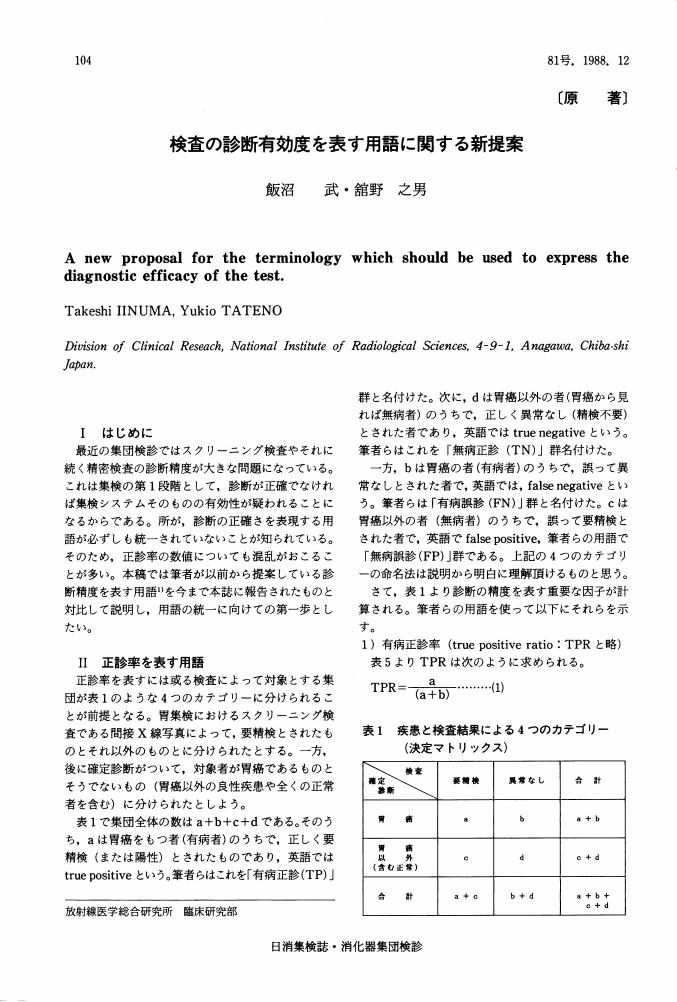2 0 0 0 OA 検査の診断有効度を表す用語に関する新提案
- 著者
- 飯沼 武 舘野 之男
- 出版者
- 一般社団法人 日本消化器がん検診学会
- 雑誌
- 消化器集団検診 (ISSN:02876132)
- 巻号頁・発行日
- vol.1988, no.81, pp.104-107, 1988-12-15 (Released:2012-12-11)
- 参考文献数
- 1
- 著者
- 山本 眞司 田中 一平 千田 昌弘 舘野 之男 飯沼 武 松本 徹 松本 満臣
- 出版者
- 一般社団法人電子情報通信学会
- 雑誌
- 電子情報通信学会論文誌. D-II, 情報・システム, II-情報処理 (ISSN:09151923)
- 巻号頁・発行日
- vol.76, no.2, pp.250-260, 1993-02-25
- 被引用文献数
- 59
肺癌早期発見のための専用CTを開発することを提唱し,その基本構想を明らかにした.次いで,このシステムに必須の診断支援用画像表示方式として,下記2方式を並列に用いることを検討し,良好な結果を得た.(1)40スライスからなる3次元情報を,病巣陰影の情報を損なうことなく2次元に投影表示する手段として,MIP(Maximum Intensity Projection)法を応用した.但し単なるMIP法では妨害臓器情報による弊害が大きいため,あらかじめこれらの不要情報をしきい値法にて除去する方式を開発した.(2)各スライス断面ごとに病巣陰影候補を自動認識し,陰影候補の見つかったCT断面のみをCRT表示することにより,表示断面を大幅に削減する方式を開発した.病巣陰影の自動認識には,我々が新たに開発したQuoit(輪投げ)フィルタを用いた.
- 著者
- 飯沼 武
- 出版者
- 日本乳癌検診学会
- 雑誌
- 日本乳癌検診学会誌 (ISSN:09180729)
- 巻号頁・発行日
- vol.21, no.2, pp.202, 2012
- 著者
- 飯沼 武 遠藤 真広 館野 之男 河内 清光 橋詰 雅 鈴木 隆一郎 中西 克己 松田 一 イイヌマ タケシ エンドウ マサヒロ タテノ ユキオ カワチ キヨミツ:ハシズメ タダシ スズキ タカイチロウ ナカニシ カツミ マツダ ハジメ Iinuma Takeshi Endo Masahiro Tateno Yukio Kawachi Kiyomitsu Hashizume Tadashi Suzuki Takaichiro Nakanishi Katsumi Matsuda Hajime
- 出版者
- 日本医学放射線学会
- 雑誌
- 日本医学放射線学会雑誌 (ISSN:00480428)
- 巻号頁・発行日
- vol.40, no.3, pp.193-201, 1980-03-25
- 著者
- 松本 満臣 堀越 浩幸 茂木 孝夫 羽鳥 昇 舘野 之男 飯沼 武 松本 徹 山本 真司 馬場 孝 マツモト ミツオミ ホリコシ ヒロユキ モテキ タカオ ハトリ ノボル タテノ ユキオ イイヌマ タケシ マツモト トオル ヤマモト シンジ ババ タカシ Matsumoto Mitsuomi Horikoshi Hiroyuki Moteki Takao Hatori Noboru Tateno Yukio Iinuma Takeshi Matsumoto Tohru Yamamoto Shinji Baba Takashi
- 出版者
- 日本医学放射線学会
- 雑誌
- 日本医学放射線学会雑誌 (ISSN:00480428)
- 巻号頁・発行日
- vol.55, no.3, pp.172-179, 1995-02-25
- 被引用文献数
- 10
- 著者
- 山県 登 岩島 清 永井 輝夫 渡利 一夫 飯沼 武
- 出版者
- Journal of Radiation Research 編集委員会
- 雑誌
- Journal of Radiation Research (ISSN:04493060)
- 巻号頁・発行日
- vol.7, no.1, pp.29-46, 1966 (Released:2006-08-29)
- 参考文献数
- 13
- 被引用文献数
- 9 13
Two single doses of coupled radioisotopes of 132Cs-86Rb and 132Cs-42K were orally administered to a human subject. Body retention, urinary and fecal excretions as well as the plasma and erythrocytes contents of radioisotopes were determined. The proportion of urinary to fecal excretion was found different in cesium and rubidium, the urinary excretion being 85.3% of the total in the former and only 68.1% in the latter. Loss of cesium in the sweat amounted to 1.5 and 3.5% of the total excretion for the first two days. Uptake by the plasma of oral dose was rapid and the whole blood content reached max. 11.4% of the dose of cesium at 1 hour, while 2.9 and 2.4% respectively of rubidium and potassium was reached. The levels in the erythrocytes seemed to grow at a slower rate in cesium than in the other alkali elements. The different feature of blood metabolism found in the alkali elements was interpreted by the slow rate of clearance of ingested cesium from blood. Daily fluctuations of fall-out 137Cs in blood and the errors involved in the assessment of the total body burden of 137Cs by blood analysis were also discussed.
1 0 0 0 OA 18FDG PETがん検診のリスク・ベネフィット解析
- 著者
- 村野 剛志 飯沼 武 舘野 之男 大崎 洋充 立石 宇貴秀 寺内 隆司 加藤 和明 井上 登美夫
- 出版者
- 公益社団法人 日本放射線技術学会
- 雑誌
- 日本放射線技術学会雑誌 (ISSN:03694305)
- 巻号頁・発行日
- vol.64, no.9, pp.1151-1156, 2008-09-20 (Released:2008-10-08)
- 参考文献数
- 15
- 被引用文献数
- 2 2 1
The benefits of 18F-fluorodeoxyglucose (18FDG) positron emission tomography (PET) cancer screening are expected to include a large population of examinees and are intended for a healthy group. Therefore, we attempted to determine the benefit/risk ratio, estimated risk of radiation exposure, and benefit of cancer detection. We used software that embodied the method of the International Commission on Radiological Protection (ICRP) to calculate the average duration of life of radiation exposure. We calculated the lifesaving person years of benefit to be obtained by 18FDG PET cancer screening detection. We also calculated the benefit/risk ratio using life-shortening and lifesaving person years. According to age, the benefit/risk ratio was more than 1 at 35–39 years old for males and 30–34 years old for females. 18FDG PET cancer screening also is effective for examinees older than this. A risk-benefit analysis of 18FDG-PET/computed tomography (CT) cancer screening will be necessary in the future.
